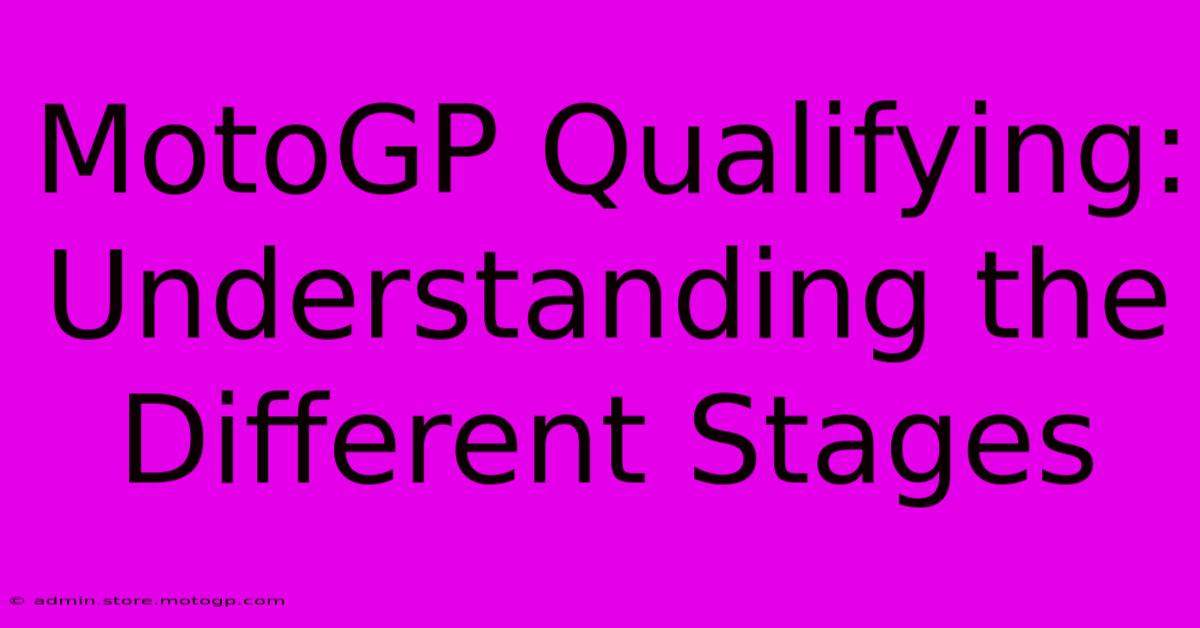MotoGP Qualifying: Understanding The Different Stages

Table of Contents
MotoGP Qualifying: Understanding the Different Stages
MotoGP qualifying is a crucial part of the weekend, setting the grid for the race and influencing the outcome significantly. Understanding the different stages is key to appreciating the drama and strategy involved. This guide breaks down the process, explaining each stage and the factors contributing to success.
The Qualifying Format: A Breakdown
The current MotoGP qualifying format consists of three sessions: Q1, Q2, and FP (Free Practice) sessions that influence qualification.
Free Practice (FP): Setting the Stage
While not technically part of qualifying, the Free Practice sessions (FP1, FP2, and FP3) are vital. They allow riders to test different setups, assess track conditions, and find the optimal racing line. Importantly, the combined times from FP1-FP3 determine who progresses directly to Q2. This means riders need to perform consistently across all three practice sessions to secure their place. A strong performance in FP can significantly ease the pressure in qualifying.
Q1: The Fight for Q2
Q1 is a 15-minute session for the riders who didn't achieve a top-ten combined time across the Free Practice sessions. It's a high-stakes battle where only the top two riders automatically progress to Q2. The intensity is palpable, with riders pushing their bikes to the limit to secure that crucial advancement. This session highlights the importance of consistent performance throughout the weekend, as a single mistake can cost a rider a place in the coveted Q2. Strategy and tire management become key considerations here.
Q2: The Pole Position Showdown
Q2 is where the real drama unfolds. This 15-minute session involves the top ten riders from the combined FP times, along with the two fastest riders from Q1. The fight for pole position is fierce, with every tenth of a second crucial. The pressure is intense, as securing pole position offers a significant advantage for the race. This session often witnesses a flurry of quick laps, strategic tire choices, and nail-biting moments. The fastest rider in Q2 earns pole position, securing the best starting spot on the grid for Sunday's race.
Factors Influencing Qualifying Performance
Several factors can influence a rider's performance during qualifying:
- Track Conditions: Temperature, humidity, and the presence of wind or rain significantly affect grip and bike performance. Adapting to changing track conditions is crucial for success.
- Tire Choice: Selecting the right tires for qualifying is a strategic decision, as the compounds offer varying levels of grip and durability. Riders and teams carefully analyze weather forecasts and track conditions to make the optimal choice.
- Bike Setup: Fine-tuning the bike's setup is essential for maximizing performance. Even small adjustments can make a significant difference in lap times.
- Rider Skill and Experience: Ultimately, a rider's skill and experience play a crucial role in their qualifying performance. The ability to push the bike to its limits, manage tire wear, and maintain consistency is vital for success.
- Team Strategy: The team's strategy also plays a critical role. This involves planning tire usage, determining the optimal qualifying runs, and supporting the rider's efforts through data analysis and support.
The Importance of Qualifying in MotoGP
Qualifying isn't just about securing a good starting position; it influences several aspects of the race. A strong qualifying performance can:
- Improve Race Starting Position: A better starting grid position usually translates to a better chance of securing a podium finish or even winning the race.
- Set the Stage for Race Strategy: The starting position influences race strategy, allowing riders to plan their overtaking maneuvers.
- Boost Rider Confidence: A good qualifying performance can boost the rider's confidence heading into the race, contributing to a better overall performance.
MotoGP qualifying is a thrilling spectacle. By understanding the different stages and the factors influencing performance, you'll be better equipped to appreciate the strategic elements and intense competition that define this crucial part of the MotoGP weekend.

Thank you for visiting our website wich cover about MotoGP Qualifying: Understanding The Different Stages. We hope the information provided has been useful to you. Feel free to contact us if you have any questions or need further assistance. See you next time and dont miss to bookmark.
Featured Posts
-
Lot R Cota The Future Of Relevant Industry
Feb 19, 2025
-
Moto Gp Sprintrennen Witness History In The Making
Feb 19, 2025
-
Aerodynamics The Key To Moto Gps Thrilling Races
Feb 19, 2025
-
Moto Gp Streams Get The Adrenaline Rush Live
Feb 19, 2025
-
Experience Moto Gp Like Never Before Tnt Sports
Feb 19, 2025
